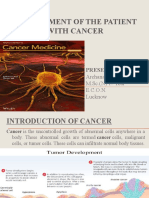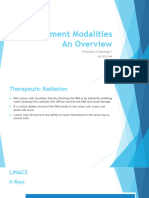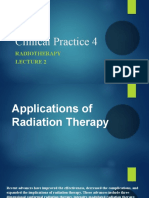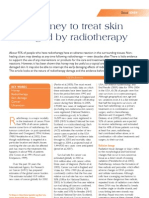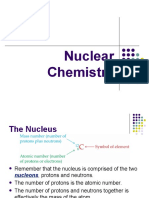0 ratings0% found this document useful (0 votes)
6 viewsRadiation Therapy
Radiation Therapy
Uploaded by
Jils SureshCopyright:
© All Rights Reserved
Available Formats
Download as PPTX, PDF, TXT or read online from Scribd
Radiation Therapy
Radiation Therapy
Uploaded by
Jils Suresh0 ratings0% found this document useful (0 votes)
6 views13 pagesCopyright
© © All Rights Reserved
Available Formats
PPTX, PDF, TXT or read online from Scribd
Share this document
Did you find this document useful?
Is this content inappropriate?
Copyright:
© All Rights Reserved
Available Formats
Download as PPTX, PDF, TXT or read online from Scribd
Download as pptx, pdf, or txt
0 ratings0% found this document useful (0 votes)
6 views13 pagesRadiation Therapy
Radiation Therapy
Uploaded by
Jils SureshCopyright:
© All Rights Reserved
Available Formats
Download as PPTX, PDF, TXT or read online from Scribd
Download as pptx, pdf, or txt
You are on page 1of 13
RADIATION THERAPY
Mr. Jils Suresh MSc (N)
• In radiation therapy, ionizing radiation is used to interrupt cellular growth. More than half of
patients with cancer receive a form of radiation therapy at some point during treatment.
INDICATIONS
Radiation may be used to cure the cancer, as in
Hodgkin’s disease which is (a cancer originating from white blood cells called lymphocytes)
Testicular seminomas (germ cell(biological cell that gives rise to the gametes ) tumor of the
testis),
Thyroid carcinomas, localized cancers of the head and neck, and cancers of the uterine cervix.
Radiation therapy may also be used to control malignant disease when a tumor cannot be
removed surgically or when local nodal metastasis is present, or it can be used prophylactically
to prevent leukemic infiltration to the brain or spinal cord.
Palliative radiation therapy is used to relieve the symptoms of metastatic disease, especially
when the cancer has spread to brain, bone, or soft tissue, or to treat oncologic emergencies,
such as superior vena cava syndrome or spinal cord compression.
TYPES OF RADIATIONS USED
Two types of ionizing radiation—electromagnetic rays (x-rays and gamma rays) and
particles (electrons [beta particles], protons, neutrons, and alpha particles)—can
lead to tissue disruption.
MECHANISM OF ACTION
The most harmful tissue disruption is the alteration of the DNA molecule within the cells of the tissue. Ionizing
radiation breaks the strands of the DNA helix, leading to cell death. Ionizing radiation can also ionize constituents of
body fluids, especially water, leading to the formation of free radicals and irreversibly damaging DNA. If the DNA is
incapable of repair, the cell may die immediately, or it may initiate cellular suicide (apoptosis), a genetically
programmed cell death.
Cells are most vulnerable to the disruptive effects of radiation during DNA synthesis and mitosis (early S, G2,
and M phases of the cell cycle). Therefore, those body tissues that undergo frequent cell division are most sensitive to
radiation therapy. These tissues include bone marrow, lymphatic tissue, epithelium of the gastrointestinal tract, hair
cells, and gonads.
Slower-growing tissues or tissues at rest are relatively radioresistant (less sensitive to the effects of radiation).
Such tissues include muscle, cartilage, and connective tissues.
Tumors that are well oxygenated also appear to be more sensitive to radiation. In theory, therefore, radiation
therapy may be enhanced if more oxygen can be delivered to tumors.
In addition, Certain chemicals, including chemotherapy agents, act as radiosensitizers and sensitize more
hypoxic (oxygen-poor) tumors to the effects of radiation therapy.
Radiation is delivered to tumor sites by external or internal means.
EXTERNAL RADIATION
If external radiation therapy is used, one of several delivery methods may be chosen,
depending on the depth of the tumor. Depending on the amount of energy they contain, x-rays can
be used to destroy cancerous cells at the skin surface or deeper in the body. The higher the energy,
the deeper the penetration into the body.
1. Kilovoltage therapy devices deliver the maximal radiation dose to superficial lesions, such as
lesions of the skin and breast,
2. Linear accelerators and betatron machines produce higher-energy x-rays and deliver their
dosage to deeper structures with less harm to the skin and less scattering of radiation within the
body tissues.
3. Gamma rays are another form of energy used in radiation therapy. This energy is produced
from the spontaneous decay of naturally occurring radioactive elements such as cobalt 60.
4. The gamma rays also deliver this radiation dose beneath the skin surface, sparing skin tissue
from adverse effects.
INTERNAL RADIATION
Internal radiation implantation, or brachytherapy, delivers a high dose of radiation to a localized area.
The specific radioisotope for implantation is selected on the basis of its half-life, which is the time it
takes for half of its radioactivity to decay.
This internal radiation can be implanted by means of needles, seeds, beads, or catheters into body
cavities (vagina, abdomen, pleura) or interstitial compartments (breast).
Brachytherapy may also be administered orally as with the isotope I 131, used to treat thyroid
carcinomas.
Intracavitary radioisotopes are frequently used to treat gynecologic cancers.
In these malignancies, the radioisotopes are inserted into specially positioned applicators after the
position is verified by x-ray.
These radioisotopes remain in place for a prescribed period and then are removed. Patients are
maintained on bed rest.
RADIATION DOSAGE
The radiation dosage is dependent on the sensitivity of the target tissues to radiation and on
the tumor size. The lethal tumor dose is defined as that dose that will eradicate 95% of the tumor
yet preserve normal tissue.
The total radiation dose is delivered over several weeks to allow healthy tissue to repair and to
achieve greater cell kill by exposing more cells to the radiation as they begin active cell division.
TOXICITY
Toxicity of radiation therapy is localized to the region being irradiated.
Acute local reactions occur when normal cells in the treatment area are also destroyed and cellular death exceeds
cellular regeneration.
Body tissues most affected are those that normally proliferate rapidly, such as the skin, the epithelial lining of
the gastrointestinal tract, including the oral cavity, and the bone marrow.
Altered skin integrity is a common effect and can include alopecia (hair loss), erythema, and shedding of skin
(desquamation).
After treatments have been completed, reepithelialization occurs.
Alterations in oral mucosa secondary to radiation therapy include stomatitis, xerostomia (dryness of the mouth),
change and loss of taste, and decreased salivation. The entire gastrointestinal mucosa may be involved, and
esophageal irritation with chest pain and dysphagia may result. Anorexia, nausea, vomiting, and diarrhea may occur
if the stomach or colon is in the irradiated field.
Bone marrow cells proliferate rapidly, and if bone marrow– producing sites are included in the radiation field
anemia, leucopenia (decreased white blood cells [WBCs]), and thrombocytopenia (a decrease in platelets) may
result.
TOXICITY
Patients are then at increased risk for infection and bleeding until blood cell counts return to
normal. Chronic anemia may occur. Certain systemic side effects are also commonly experienced
by patients receiving radiation therapy. These manifestations, which are generalized, include
fatigue, malaise, and anorexia. This syndrome may be secondary to substances released when
tumor cells break down. The effects are temporary and subside with the cessation of treatment.
Late effects of radiation therapy may also occur in various body tissues. These effects are
chronic, usually produce fibrotic changes secondary to a decreased vascular supply, and are
irreversible. These late effects can be most severe when they involve vital organs such as the
lungs, heart, central nervous system, and bladder. Toxicities may intensify when radiation is
combined with other treatment modalities.
NURSING MANAGEMENT IN RADIATION THERAPY
The patient receiving radiation therapy and the family often have questions and
concerns about its safety. To answer questions and allay fears about the effects of
radiation on others, on the tumor, and on the patient’s normal tissues and organs, the
nurse can explain the procedure for delivering radiation and describe the equipment,
the duration of the procedure (often minutes only), the possible need for
immobilizing the patient during the procedure, and the absence of new sensations,
including pain, during the procedure. If a radioactive implant is used, the nurse
informs the patient and family about the restrictions placed on visitors and health
care personnel and other radiation precautions. Patients also need to understand
their own role before, during, and after the procedure.
NURSING MANAGEMENT IN RADIATION THERAPY
PROTECTING THE SKIN AND ORAL MUCOSA
The nurse assesses the patient’s skin, nutritional status, and general feeling of well-being.
The skin and oral mucosa are assessed frequently for changes (particularly if radiation therapy
is directed to these areas).
The skin is protected from irritation, and the patient is instructed to avoid using ointments,
lotions, or powders on the area.
Gentle oral hygiene is essential to remove debris, prevent irritation, and promote healing.
If systemic symptoms, such as weakness and fatigue, occur, the patient may need assistance
with activities of daily living and personal hygiene. Additionally, the nurse offers reassurance
by explaining that these symptoms are a result of the treatment and do not represent
deterioration or progression of the disease.
NURSING MANAGEMENT IN RADIATION THERAPY
PROTECTING THE CAREGIVERS
When a patient has a radioactive implant in place, nurses and other health care providers need
to protect themselves as well as the patient from the effects of radiation.
Specific instructions are usually provided by the radiation safety officer from the x-ray
department.
The instructions identify the maximum time that can be spent safely in the patient’s room, the
shielding equipment to be used, and special precautions and actions to be taken if the implant
is dislodged.
The nurse should explain the rationale for these precautions to keep the patient from feeling
unduly isolated.
You might also like
- Student Exploration: Half-Life: Vocabulary: Daughter Atom, Decay, Geiger Counter, Half-Life, Isotope, Neutron, RadiationDocument5 pagesStudent Exploration: Half-Life: Vocabulary: Daughter Atom, Decay, Geiger Counter, Half-Life, Isotope, Neutron, RadiationSai83% (6)
- Radiation TherapyDocument58 pagesRadiation TherapyRichard Allan SolivenNo ratings yet
- Radiation TherapyDocument4 pagesRadiation Therapypanniyin selvanNo ratings yet
- OverviewDocument6 pagesOverviewarakbaeNo ratings yet
- Radiotherapy - Radio OncologyDocument11 pagesRadiotherapy - Radio OncologyyiafkaNo ratings yet
- Radiography Safety ProcedureDocument9 pagesRadiography Safety ProcedureأحمدآلزهوNo ratings yet
- Brach y TherapyDocument6 pagesBrach y TherapyRetchel LosariaNo ratings yet
- Radiology - Examination Methods 2Document78 pagesRadiology - Examination Methods 2Abishek DhinakaranNo ratings yet
- How Does Radiation Therapy Work?Document5 pagesHow Does Radiation Therapy Work?mikeadrianNo ratings yet
- Management of Patient With CancerDocument52 pagesManagement of Patient With CancerAru VermaNo ratings yet
- Palliative Radiation TherapyDocument7 pagesPalliative Radiation TherapyJohnasse Sebastian NavalNo ratings yet
- Radiotherapy in Management of Head and Neck CancerDocument51 pagesRadiotherapy in Management of Head and Neck CancerKassim OboghenaNo ratings yet
- Assignment On Radiation TherapyDocument16 pagesAssignment On Radiation TherapyAxsa AlexNo ratings yet
- Radiation TherapyDocument7 pagesRadiation TherapyMeenakshi VyasNo ratings yet
- Stimulus Material (3 Sources)Document6 pagesStimulus Material (3 Sources)Isaac JTNo ratings yet
- Managments in Oncology 13OCTDocument49 pagesManagments in Oncology 13OCTM ANo ratings yet
- Andrew Idoko Radiology GROUP 332 1. The Concept of Radical and Palliative Treatment. Indications, Contraindications Dose Limits. ExamplesDocument5 pagesAndrew Idoko Radiology GROUP 332 1. The Concept of Radical and Palliative Treatment. Indications, Contraindications Dose Limits. ExamplesdreNo ratings yet
- S - Radiation and ChemotherapyDocument57 pagesS - Radiation and ChemotherapySusovan GiriNo ratings yet
- RadiotherapyDocument64 pagesRadiotherapyPranshu TomerNo ratings yet
- Principles of Diathermy, Radiotherapy and Anesthesia: Dr. Amar KumarDocument18 pagesPrinciples of Diathermy, Radiotherapy and Anesthesia: Dr. Amar KumarSudhanshu ShekharNo ratings yet
- Radiation Therapy 2013Document59 pagesRadiation Therapy 2013AydinNo ratings yet
- 6 - Treatment ModalitiesDocument36 pages6 - Treatment ModalitiesAlexa RodriguezNo ratings yet
- Principles of Radiation OncologyDocument22 pagesPrinciples of Radiation OncologyGina RNo ratings yet
- Radiation Hazards 2Document19 pagesRadiation Hazards 2Rupender HoodaNo ratings yet
- Radiation Therapy For CancerDocument65 pagesRadiation Therapy For CancermelNo ratings yet
- Update of Radiotherapy For Skin Cancer: Review ArticlesDocument8 pagesUpdate of Radiotherapy For Skin Cancer: Review ArticlesOscar Frizzi100% (1)
- Linac Report FINALDocument32 pagesLinac Report FINALJasmine KaurNo ratings yet
- Positive Effects of The Electromagnetic RadiationDocument8 pagesPositive Effects of The Electromagnetic RadiationTyrone Stavros BarracaNo ratings yet
- 8 - Cancer - ManagementDocument90 pages8 - Cancer - ManagementMaviel Maratas SarsabaNo ratings yet
- Wa0004.Document20 pagesWa0004.Mayra AlejandraNo ratings yet
- Radiation TherapyDocument11 pagesRadiation Therapyrnnr2159No ratings yet
- Radiation Therapy-Guidelines For PhysiotherapistsDocument9 pagesRadiation Therapy-Guidelines For PhysiotherapistsSofia Adão da FonsecaNo ratings yet
- 1Document2 pages1Shiella Mae SalamanesNo ratings yet
- OncoDocument13 pagesOncozharifderisNo ratings yet
- Radiation TherapyDocument218 pagesRadiation Therapyjerax116No ratings yet
- Complete Oncology by GS Medical AcademyDocument78 pagesComplete Oncology by GS Medical Academyjaydangar15No ratings yet
- NCM106-Cellular Aberrations-Module1-Lesson 4Document10 pagesNCM106-Cellular Aberrations-Module1-Lesson 4Esmareldah Henry SirueNo ratings yet
- Radiation Therapy Toxicity To The Skin Derm Clin 2008Document12 pagesRadiation Therapy Toxicity To The Skin Derm Clin 2008Ana Karina Alvarado OsorioNo ratings yet
- Radiotherapy For CancerDocument12 pagesRadiotherapy For CancerAshfiya ShaikhNo ratings yet
- Non Surgical Treatment Modalities of SCCHN: Presentation by Post Gradute StudentDocument113 pagesNon Surgical Treatment Modalities of SCCHN: Presentation by Post Gradute StudentZubair VajaNo ratings yet
- Tumor Ablation and NanotechnologyDocument19 pagesTumor Ablation and NanotechnologyLoredana VoiculescuNo ratings yet
- Basic Principles of Radiation OncologyDocument34 pagesBasic Principles of Radiation OncologyEstiani Ningsih100% (1)
- The Science of Gay and TreatmentDocument1 pageThe Science of Gay and TreatmentJahred BoddenNo ratings yet
- Radiation Oncology A Physicists Eye ViewDocument332 pagesRadiation Oncology A Physicists Eye Viewquyen2012100% (1)
- L15 - Effect of Radiation 2Document41 pagesL15 - Effect of Radiation 2Obahakam_917038774No ratings yet
- Jurnal Bedah FamelaDocument23 pagesJurnal Bedah FamelaIkhlas Anggie Kay MayNo ratings yet
- Biological Effects of Radiation & Safety ConsiderationDocument21 pagesBiological Effects of Radiation & Safety ConsiderationTareq AzizNo ratings yet
- Principles of Radiotherapy 2016Document85 pagesPrinciples of Radiotherapy 2016Ali B. SafadiNo ratings yet
- What Is Interventional RadiologyDocument8 pagesWhat Is Interventional RadiologyNIMKY EMBER B. CLAMOHOYNo ratings yet
- Telomerase Low-Level Laser Therapy Effects On Human Face AgedDocument6 pagesTelomerase Low-Level Laser Therapy Effects On Human Face AgedcumbredinNo ratings yet
- Clinical Practice 4: RadiotherapyDocument46 pagesClinical Practice 4: Radiotherapyallord100% (1)
- تقرير عن السرطانDocument39 pagesتقرير عن السرطانSadon B AsyNo ratings yet
- Radiation TherapyDocument28 pagesRadiation Therapypalakkhurana012No ratings yet
- 2021 Trauma and Emergency Surgery - The Role of Damage Control Surgery (Georgios Tsoulfas, Mohammad Meshkini)Document124 pages2021 Trauma and Emergency Surgery - The Role of Damage Control Surgery (Georgios Tsoulfas, Mohammad Meshkini)Lexotanyl LexiNo ratings yet
- 10 Biohazards of RadiationDocument49 pages10 Biohazards of RadiationMunazzaNo ratings yet
- Radiation PoisioningDocument28 pagesRadiation PoisioningArunNo ratings yet
- Principles of Chemotherapy and Radiotherapy PDFDocument7 pagesPrinciples of Chemotherapy and Radiotherapy PDFNora100% (3)
- Using Honey To Treat Skin Damaged by RadiotherapyDocument4 pagesUsing Honey To Treat Skin Damaged by RadiotherapyDoddy SumardhikaNo ratings yet
- Radiation TherapyDocument1 pageRadiation TherapyJayadi D. RaNo ratings yet
- PH504 - L7 - Management of CancerDocument19 pagesPH504 - L7 - Management of Cancerjohnkabir539No ratings yet
- Cancer Textbook 4 (Cancer Treatment and Ovarian Cancer)From EverandCancer Textbook 4 (Cancer Treatment and Ovarian Cancer)No ratings yet
- Newborn ReflexesDocument12 pagesNewborn ReflexesJils SureshNo ratings yet
- ThrombosisDocument2 pagesThrombosisJils SureshNo ratings yet
- Pathology of Pulmonary TBDocument3 pagesPathology of Pulmonary TBJils SureshNo ratings yet
- School AgeDocument10 pagesSchool AgeJils SureshNo ratings yet
- Toddler Growth and DevelopmentDocument20 pagesToddler Growth and DevelopmentJils SureshNo ratings yet
- The Normal Toddler Growth and DevelopmentDocument8 pagesThe Normal Toddler Growth and DevelopmentJils SureshNo ratings yet
- Seminar and SymposiumDocument13 pagesSeminar and SymposiumJils SureshNo ratings yet
- Neurologic DisorderDocument77 pagesNeurologic DisorderJils SureshNo ratings yet
- WeaningDocument4 pagesWeaningJils SureshNo ratings yet
- Ratng ScaleDocument6 pagesRatng ScaleJils SureshNo ratings yet
- ChemotherapyDocument15 pagesChemotherapyJils SureshNo ratings yet
- Cancer of The CervixDocument14 pagesCancer of The CervixJils SureshNo ratings yet
- Hirschsprung DiseaseDocument28 pagesHirschsprung DiseaseJils SureshNo ratings yet
- Growth and Development of PreschoolerDocument6 pagesGrowth and Development of PreschoolerJils SureshNo ratings yet
- Gastric CancerDocument16 pagesGastric CancerJils SureshNo ratings yet
- GastroenteritisDocument14 pagesGastroenteritisJils SureshNo ratings yet
- Typhoid in ChildrenDocument3 pagesTyphoid in ChildrenJils SureshNo ratings yet
- Breast CancerDocument27 pagesBreast CancerJils SureshNo ratings yet
- OncologyDocument24 pagesOncologyJils SureshNo ratings yet
- Laryngeal CancerDocument13 pagesLaryngeal CancerJils SureshNo ratings yet
- Oral CancerDocument11 pagesOral CancerJils SureshNo ratings yet
- Thermo Scientific FHZ 691-10: Wide-Range Dose Rate ProbeDocument2 pagesThermo Scientific FHZ 691-10: Wide-Range Dose Rate ProbeSkjhkjhkjhNo ratings yet
- New and Expectant Mother Risk AssessmentDocument30 pagesNew and Expectant Mother Risk Assessmentolanda MohammedNo ratings yet
- Laws of Malaysia - Act 304 - Atomic Energy Licensing Act 1984Document40 pagesLaws of Malaysia - Act 304 - Atomic Energy Licensing Act 1984j李枂洙No ratings yet
- Poster Medicina Nuclear en NiñosDocument1 pagePoster Medicina Nuclear en NiñosLuisNo ratings yet
- Icrp 94 Radiological ProtectionDocument84 pagesIcrp 94 Radiological ProtectionBudi ArifNo ratings yet
- 3.2.2 RI Sup. - Training Booklet 000521Document28 pages3.2.2 RI Sup. - Training Booklet 000521Mathew Kurian100% (2)
- CHEM1104 Nuclear ChemistryDocument46 pagesCHEM1104 Nuclear ChemistryPaul Jhon EugenioNo ratings yet
- Geology Essay FinalDocument4 pagesGeology Essay FinalMomen BtoushNo ratings yet
- Instant Download Test Bank For Essentials of Radiographic Physics and Imaging 2nd Edition by Johnston PDF All ChapterDocument35 pagesInstant Download Test Bank For Essentials of Radiographic Physics and Imaging 2nd Edition by Johnston PDF All Chapterranoeotb100% (6)
- ASPIRO TechnologyDocument19 pagesASPIRO Technologysehyong0419No ratings yet
- Suspected Small Bowel ObstructionDocument10 pagesSuspected Small Bowel ObstructionFachry MuhammadNo ratings yet
- PTW Ciriementor 2Document2 pagesPTW Ciriementor 2Φανης πετροNo ratings yet
- Radiotherapy: IPEM Grade A' Training PortfolioDocument9 pagesRadiotherapy: IPEM Grade A' Training PortfoliorodricesarNo ratings yet
- IgCse Physics NotesDocument6 pagesIgCse Physics Notessalvatourelena25353No ratings yet
- Pub1215 Web NewDocument71 pagesPub1215 Web NewMehdiNo ratings yet
- 559-Texto Del Artículo-2459-4-10-20190625Document13 pages559-Texto Del Artículo-2459-4-10-20190625RodomaxNo ratings yet
- TM 502Document10 pagesTM 502teresa tsoiNo ratings yet
- Radiation Training - Compatibility ModeDocument19 pagesRadiation Training - Compatibility ModePirama RayanNo ratings yet
- Thesis StatementDocument4 pagesThesis StatementBlessyJoyPunsalanNo ratings yet
- Salomon E. Liverhant - Elementary Introduction To Nuclear Reactor Physics-John Wiley & Sons LTD (1966) (Z-Lib - Io)Document466 pagesSalomon E. Liverhant - Elementary Introduction To Nuclear Reactor Physics-John Wiley & Sons LTD (1966) (Z-Lib - Io)imran hossainNo ratings yet
- 2010-2011 UOIT ViewbookDocument40 pages2010-2011 UOIT ViewbookuoitNo ratings yet
- Script & Summary of Marie CurieDocument2 pagesScript & Summary of Marie CurieGrace Victoria Poo 1428041No ratings yet
- Radiography Permit: Al-Dur 2 Iwpp ProjectDocument1 pageRadiography Permit: Al-Dur 2 Iwpp ProjectJianping KeNo ratings yet
- Phy 5 and 6 SemDocument25 pagesPhy 5 and 6 SemChetan KumarNo ratings yet
- Physics Project: Class:XII-B Roll Number:34Document6 pagesPhysics Project: Class:XII-B Roll Number:34SSTGNo ratings yet
- Evaluation of Natural Radioactivity and Hazard Indices in The Soil Collected From The Residential College Areas of University Malaya, MalaysiaDocument90 pagesEvaluation of Natural Radioactivity and Hazard Indices in The Soil Collected From The Residential College Areas of University Malaya, MalaysiaChaouki LakehalNo ratings yet
- Occupational Health and SafetyDocument16 pagesOccupational Health and SafetySachin Dwivedi100% (1)
- Properties of Alpha, Beta and Gamma.Document3 pagesProperties of Alpha, Beta and Gamma.Allen Raleigh TesoroNo ratings yet
- Fission QuestionsDocument4 pagesFission QuestionsaninatkhanNo ratings yet









